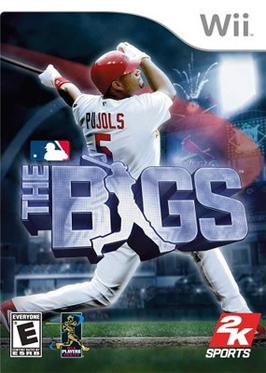
The Bigs is an arcade-style baseball video game for the Xbox 360, PlayStation 3, PlayStation 2, Wii and PlayStation Portable. It was released in June 2007 in North America, and in October in the PAL region. A sequel, The Bigs 2, was released on July 7, 2009.

The Saboteur is an action-adventure video game developed by Pandemic Studios and published by Electronic Arts. It was released for Microsoft Windows, PlayStation 3 and Xbox 360 in December 2009 and eventually on Steam on March 7, 2024. A mobile version of the game was developed and released by Hands-On Mobile for BlackBerry on January 21, 2010, for iOS on March 24, 2010. The game is set in German-occupied France during World War II, and follows Sean Devlin, an Irish race car driver and mechanic, who joins the French Resistance to liberate Paris after his best friend is killed by Nazi forces.
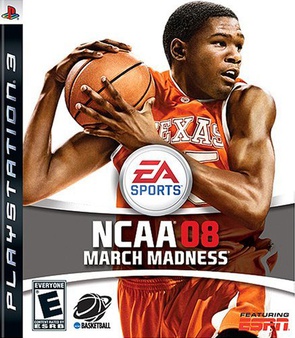
NCAA March Madness 08 is the 2007 installment in the NCAA March Madness series. Former University of Texas and current Phoenix Suns forward Kevin Durant is featured on the cover. It was the only March Madness game available for the PlayStation 3 until the name change.

Top Spin 3 is the third title in the Top Spin series of video games. The game was developed by PAM Development and published by 2K. New game elements include real-time weather effects, more options of professional tennis players, an in-depth character creation tool and new unparalleled gameplay mechanics. It also features impressive advancements in an audio/visual sense with improved Dolby Digital surround sound and "Evolutionary" visuals. Top Spin 4 was released as a sequel about three years later.

Bionic Commando is a 2009 action-adventure video game, part of the Bionic Commando series. The game was developed by Swedish developer Grin and published by Capcom. The game is a sequel to the 1988 NES game Bionic Commando, with certain storyline elements taken from its 2008 remake Bionic Commando Rearmed. The game runs on Grin's Diesel engine.

Dark Void is a third-person shooter video game developed by Airtight Games and published by Capcom. It was originally released in January 2010 for the PlayStation 3, Xbox 360 and Microsoft Windows. In the game, players must face an alien threat that humanity had previously banished. The game uses Unreal Engine 3. A Games for Windows – Live version was also released on April 21, 2010.
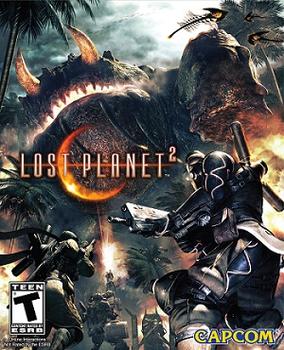
Lost Planet 2 is a third-person shooter video game developed and published by Capcom and Beeline Interactive, Inc. The game is the sequel to Lost Planet: Extreme Condition, taking place ten years after the events of the first game, on the same planet. The game was developed for BlackBerry, PlayStation 3, Xbox 360 and Microsoft Windows. Originally set to be released in early 2010, Capcom delayed the game's consoles release to May 11, 2010 in North America and Europe, May 13 in Australia and May 20 for Japan, while the BlackBerry version was released worldwide on April 28 and the Microsoft Windows version was released in October that year. The title sold more than 1.5 million copies worldwide.

UEFA Euro 2008 is the official video game of the Euro 2008 football tournament, published by EA Sports. It was developed collaboratively by EA Canada and HB Studios and was released in Europe and North America on 18 April 2008 and 19 May 2008 respectively. The commentary was provided by Clive Tyldesley and Andy Townsend.

Beijing 2008 is the official Olympic video game of the 2008 Summer Olympics held in Beijing. Developed by Eurocom and published by Sega, the game was the second video game based on the 2008 Summer Olympics to be released, the first being the fantasy-based Mario & Sonic at the Olympic Games which appeared in late 2007; however, Beijing 2008 is a realistic sports simulation.

Stormrise is a real-time tactics video game developed by Creative Assembly's Australian studio and published by Sega for Microsoft Windows, PlayStation 3, and Xbox 360. It's set in a post-apocalyptic world.

Wolfenstein is a first-person shooter video game developed by Raven Software and published by Activision, part of the Wolfenstein video game series. It serves as a loose sequel to the 2001 entry Return to Castle Wolfenstein, and uses an enhanced version of id Software's id Tech 4. The game was released in August 2009 for Microsoft Windows, PlayStation 3 and Xbox 360.

Wanted: Weapons of Fate is a third-person shooter video game, first developed and published by I-play in 2008, before being developed by Grin and published by Warner Bros. Interactive and distributed by Universal Studios in 2009, based on the film of the same name. It was released for mobile phones, Microsoft Windows, PlayStation 3 and Xbox 360.
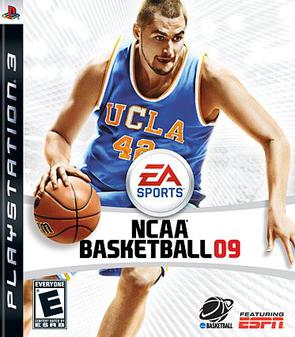
NCAA Basketball 09 is the 2008 installment in the NCAA Basketball series. It was released on November 17, 2008 for the PlayStation 3, PlayStation 2, and Xbox 360. Miami Heat player Kevin Love is featured on the cover. A special edition called NCAA Basketball 09: March Madness Edition was released only for Xbox 360 on March 11, 2009.

The Bigs 2 is a baseball sports video game developed by Blue Castle Games and published by 2K for the Xbox 360, PlayStation 3, PlayStation 2, Wii, and PlayStation Portable. The game serves as the direct sequel to The Bigs. The first trailer for the game was released revealing players like Ozzie Smith, Wade Boggs, Roberto Clemente, and Reggie Jackson and a number of other Hall of Famers. Milwaukee Brewers All-Star first baseman Prince Fielder is the cover athlete chosen by 2K Sports. For the Xbox 360, PlayStation 3 and Wii editions of the game, the English play-by-play announcer is Damon Bruce while the Japanese announcer is Kasey Ryne Mazak. It was released in 2009. The game was indirectly followed-up by Nicktoons MLB.

UFC Undisputed 2010 is a mixed martial arts fighting game featuring Ultimate Fighting Championship (UFC) properties and fighters developed by Yuke's and published by THQ in 2010 for the PlayStation 3, Xbox 360, and PlayStation Portable. It is the second game to be released under THQ's 2007 agreement with the UFC and it is a sequel to the successful UFC 2009 Undisputed. Another sequel, UFC Undisputed 3, was released in 2012.
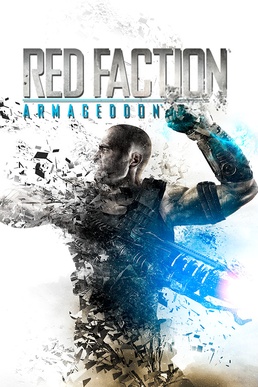
Red Faction: Armageddon is a third-person shooter video game developed by Volition and published by THQ in association with the TV network Syfy. It is the fourth and final installment in the Red Faction series, and was released for Microsoft Windows, PlayStation 3 and Xbox 360 in various countries around the world between June 7 and June 10, 2011.

Inversion is a third-person shooter video game developed by Saber Interactive and published by Bandai Namco Entertainment for Microsoft Windows, PlayStation 3 and Xbox 360. It was released on June 5, 2012 in North America, July 12, 2012 in Australia and on July 13, 2012 in Europe for PlayStation 3 and Xbox 360. It was later released for Windows on June 8, 2012 in Europe, July 12, 2012 in Australia and July 26, 2012 in North America. It features gravity manipulation and destructible environments.

Thor: God of Thunder is an action hack and slash video game based on the Marvel Studios film Thor. The game was developed by Liquid Entertainment and co-written by Matt Fraction. Thor: God of Thunder marks Thor's first standalone appearance in a video game and features the voices of Chris Hemsworth, Tom Hiddleston and Jaimie Alexander, who reprise their roles from the film. The game was released in 2011 for Nintendo DS, PlayStation 3, Wii, Xbox 360 and Nintendo 3DS. The PlayStation 3 and Xbox 360 versions of the game can be played in 3D on 3DTVs and on 2DTVs via TriOviz Inificolor 3D glasses. The PlayStation 3 and Xbox 360 versions were met with unfavorable reviews, while the Wii, DS, and 3DS versions were met with mixed reviews.

Fuse is a four-player cooperative third-person shooter video game developed by Insomniac Games and published by Electronic Arts for PlayStation 3 and Xbox 360. The game was announced as Overstrike before it was rebranded in August 2012. It was released on May 28, 2013 in North America, May 30, 2013 in Australia and on May 31, 2013 in Europe. Fuse was both a critical and commercial failure for Electronic Arts.
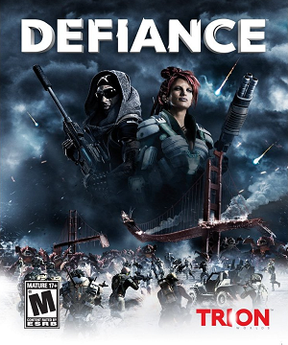
Defiance was a science fiction-themed persistent world massively multiplayer online third-person shooter developed by Trion Worlds. Defiance took place on a terraformed Earth several years into the future. It was a tie-in to the Syfy show of the same name. The game was released in April 2013 for Microsoft Windows, PlayStation 3 and Xbox 360. It was also released on Steam. The game went free-to-play on June 4, 2014 for PC, August 14, 2014 for PS3 and November 18, 2014 for Xbox 360. Official game servers, community forums, and social media outlets were shut down by owning company Gamigo on April 29, 2021.



















